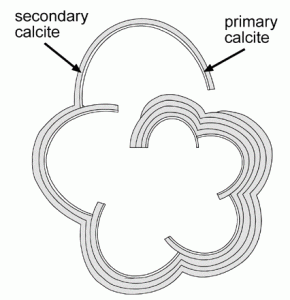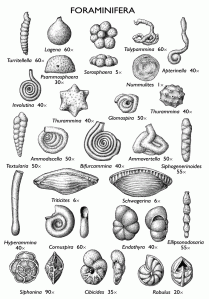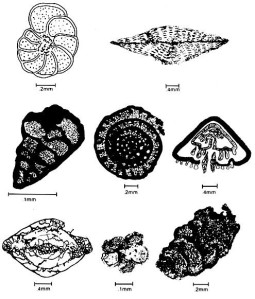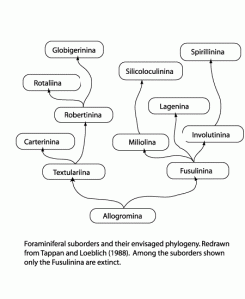In this section the evolution of diversity and morphology of Foraminifera will be discussed.
Diversity
There are two classifications of species that are important to take note of when examining the diversity of foraminifera, keeled and unkeeled species. Foraminifera with a developed keel have a thickening of the outer shell, this can be related to why some species thrive, while others are subjected to mass extinction throughout the geological timescale. Looking at when a species evolved and diversified can show possible trends.
Robertinides, Buliminides and Nodosariides evolved in the Devonian, they diversified through the Jurassic but declined in the Cenozoic. The rotaliides evolved in the Triassic but were greatly reduced by the Cretaceous mass extinction. The Globigerinides evolved in the middle Jurassic just after the Toarcian mass extinction however were reduced greatly in the cretaceous mass extinction. Microgranular foraminifera evolved in the Devonian and diversified rapidly but became extinct in the Permian mass extinction
Morphology
The morphology of all foraminifera have key characteristics that allow specific species the ability to survive in specific locations that others would not survive in. The competition for nutrients is low between species and the risk from predators is also quite low. The first foraminifera were small and rounded with spines. They evolved many different shapes (e.g triangular) and developed different sizes but at the end of the Cretaceous mass extinction only the smaller rounded species survived. The keels of different species that evolved have 5 different microstructures. These include imperforated band, the masonry keel, the double keel, the muricate keel and the inflational keel. These complex hardened outer shells are a result of the changing oceanic environments foraminifera were exposed to as there abundance grew and they spread. However similar genetic rules are evident for each of these keel constructions. That would suggest it could have been inherited from common unkeeled anchestors.

Evolution Timeline
Foraminifera first appeared in the fossil record around 525mya. They were single chambered and created their shells by cementing together grains from the seafloor. 25my later they evolved multi-chambers. 200my later they then evolved glassy walls and some species grew larger in order to host algae. Towards the early Jurassic floating foraminifera appear in the fossil record, a major step in evolution as foraminifera were only benthic. The middle Cretaceous saw a geographical spread of the species, now not restricted to deep marine environments. However at the end of the Cretaceous saw a mass extinction of the species with the smaller simpler foraminifera surviving as they remained benthic. Mass extinctions also occur in the benthic later in the early Oligocene. The Miocene saw a large number species evolving into today’s modern species of foraminifera.
References
Picture 1: Illinois State Geological Survey 2014, picture viewed on 02/03/2014 http://www.isgs.uiuc.edu/sites/isgs/files/images/outreach-images/plate-01.gif
Picture 2: SEPM Stratigraphy Web 2013, picture viewed on 02/03/2014
http://www.sepmstrata.org/CMS_Images/fig3.jpg
Picture 3: GeoScienceWorld 2003, picture viewed on 02/03/2014
http://rimg.geoscienceworld.org/content/54/1/115/F1.large.jpg
Picture 4: University College London (Undefined publish date) picture viewed on 02/03/2014
http://www.ucl.ac.uk/GeolSci/micropal/images/fora/fordiag03.gif
Text
Robert Wynn Jones (2011). Applications of Palaeontology. Cambridge: Cambridge university press. p21-22.
Michael Foote & Arnold I. Miller (2007). principles of paleontology. 3rd ed. USA: W.H Freeman & Company. p207-208.
Richard D. Norris (1991). Biased Extinction and Evolutionary Trends. Maryland: Paleontological Society. pp. 388-399.
Website
Richard Norris. (1991). Parallel Evolution in the Keel Structure of Planktonic-Foraminifera. Available: http://scrippsscholars.ucsd.edu/rnorris/content/parallel-evolution-keel-structure-planktonic-foraminifera.
.Last accessed 02/03/2014


